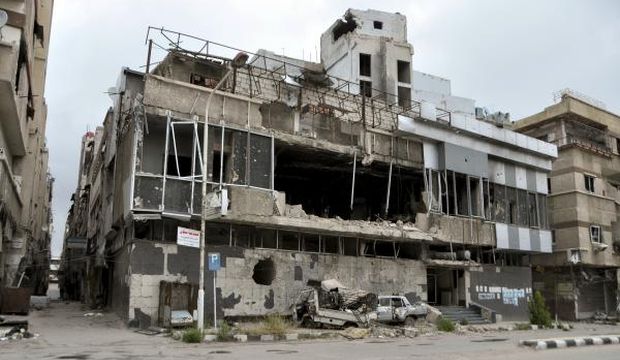
This April 10, 2015 photo shows a view of the Fayez Halawi hospital on Yarmouk Street, the main street of the Yarmouk Palestinian refugee camp, on the outskirts of the Syrian capital Damascus. (Reuters/Moayad Zaghmout)
Beirut, Asharq Al-Awsat—There have been conflicting reports emerging regarding the withdrawal of the Islamic State of Iraq and Syria (ISIS) from the Yarmouk Palestinian refugee camp, which lies on the outskirts of Damascus, with some reports saying the extremist group and others continue to hold parts of the camp.
Local sources told Reuters on Wednesday that most of the ISIS fighters who had entered the camp on April 1 had now withdrawn to their neighboring stronghold of Hajjar Al-Aswad following fierce fighting with a rival extremist group in the camp, the Palestinian Hamas-linked Aknaf Al-Maqdis.
This was echoed by Rami Abdulrahman, the head of the UK-based Syrian Observatory for Human Rights, which monitors the now four-year Syrian conflict through a network of observers on the ground. He told Asharq Al-Awsat fighters from ISIS had indeed withdrawn to Hajjar Al-Aswad—from where they had launched their initial attack on the camp.
He added that ISIS and another rival extremist group, the Al-Qaeda-linked Al-Nusra Front, continued to hold up to 80 percent of the 0.80-square mile (2-square kilometer) camp.
Abdulrahman said the apparent withdrawal represented a mere “redeployment” of forces by ISIS to northern areas of the Yarmouk camp. The camp is essentially a suburb of Damascus for Palestinian refugees, which in 2012 was estimated to be home to more than 150,000 civilians.
Other reports suggest the Al-Nusra Front, and not ISIS, is now the main extremist group with a presence in the camp.
ISIS and Al-Nusra have been fierce rivals in Syria since early on in the conflict. ISIS, like Al-Nusra, is an offshoot of Al-Qaeda, but the parent organization later disowned ISIS and proclaimed Al-Nusra its official franchise in Syria. The two groups have since been engaged in fierce fighting over territory in the country.
Reports, however, suggested the rivals joined forces in recent weeks in order to take control of the camp and drive out the Palestinian militant groups located there.
Various opposition factions as well as Syrian government forces have been vying for control of Yarmouk, continually bombarding the camp, since the start of the conflict.
Yarmouk’s proximity to central Damascus means it forms an entry point into the capital, which remains a stronghold for the regime of Bashar Al-Assad and has largely been shielded from the conflict in comparison to other major cities like Aleppo.
The humanitarian situation in Yarmouk has become especially dire in recent weeks since ISIS and Al-Nusra entered the camp. The United Nations Relief and Works Agency (UNRWA)—the UN’s specialized agency for Palestinian refugees—says the recent fighting has put some 18,000 Palestinian refugees, including 3,500 children, at “grave risk” due to lack of access to basic provisions such as food, water and healthcare.
